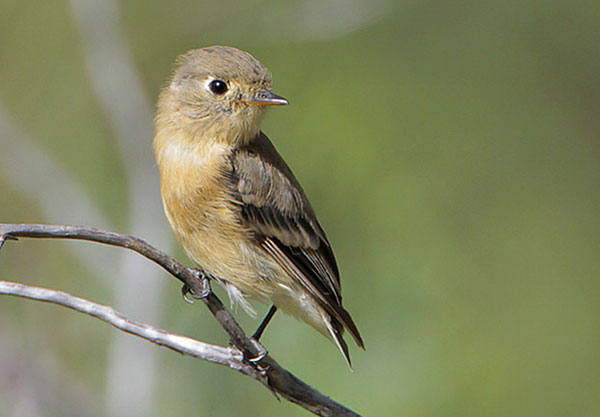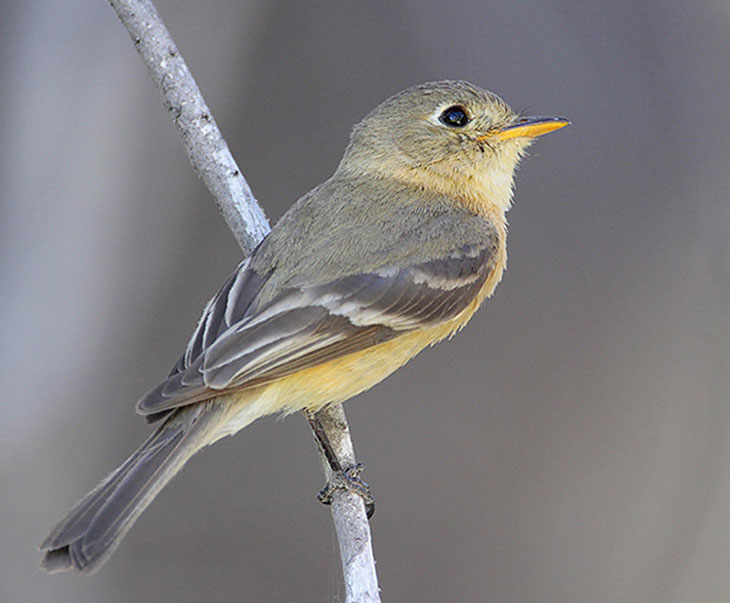Widely distributed in Central America and Mexico, the Buff-breasted Flycatcher has only a very small range in the southwestern U.S. Although it is a member of the genus Empidonax which contains several difficult to identify species, the Buff-breasted Flycatcher is distinctive in its appearance.
Accounts of nest parasitism by cowbirds are rare, and Buff-breasted Flycatchers mount a vigorous response to any cowbird near their nest. Few detailed studies of breeding ecology have been made, and little banding has been done, so much remains to be learned about this species.
On this page
Description of the Buff-breasted Flycatcher
BREEDING MALE

Photograph © Greg Lavaty
The Buff-breasted Flycatcher is a small flycatcher with a brownish back and reddish-buff breast. It has a pale eye ring and wing bars, and a yellow lower mandible.
Female
Sexes similar.
Seasonal change in appearance
None.
Juvenile
Juveniles are similar to adults.
Habitat
Pine woods.
Diet
Insects.
Behavior
Forages by watching for prey from a perch and flying out to capture it.
Range
Breeds in southeastern Arizona and is resident in much of Mexico.
Fun Facts
Only a relative handful of Buff-breasted Flycatchers occur in the U.S. each summer.
The male of a pair chases other males away from the territory, and the female sometimes chases away other females.
Vocalizations
The song sounds like “chee-lik”.
Similar Species
Other Empidonax flycatchers are grayer.
Nesting
The nest is a cup of spider webs and plant material covered with lichens and placed under an overhanging branch.
Number: 3-4. ?
Color: White.
Incubation and fledging: ?
– Young hatch at 14-16 days..
– Young fledge (leave the nest) at 15-17 days after hatching but remain with the adults for some time.
Bent Life History of the Buff-breasted Flycatcher
Published by the Smithsonian Institution between the 1920s and the 1950s, the Bent life history series of monographs provide an often colorful description of the birds of North America. Arthur Cleveland Bent was the lead author for the series. The Bent series is a great resource and often includes quotes from early American Ornithologists, including Audubon, Townsend, Wilson, Sutton and many others.
Bent Life History for the Buff-breasted Flycatcher – the common name and sub-species reflect the nomenclature in use at the time the description was written.
AMAZILIA YUCATANENSIS CHALCONOTA Oherholser
This is another Mexican species that extends its range northward into the valley of the lower Rio Grande in Texas. It is the northern form of a species inhabiting eastern Mexico and Yucatan, from the Rio Grande to extreme southeastern Mexico, which has been divided Into three subspecies. This race is described by Ridgway (1911) as “similar to A. y. cerviniventris, but under parts of body much paler (light cinnamon buff to pale pinkish buff) and green of upper parts averaging more bronzy.”
The buff-bellied hummingbird was added to our fauna by Dr. James C. Merrill (1878), who took the first specimen within our borders on the military reservation of Fort Brown, Tex., on August 17, 1876. He found it to be an “abundant summer visitor” and says that “it seems perfectly at home among the dense, tangled thickets, darting rapidly among the bushes and creeping vines, and is with difficulty obtained. A rather noisy bird, its shrill cries usually first attract one’s attention to its presence.”
While George F. Simmons and I were collecting with R. D. Camp, near Brownsville, Tex., in 1923, Captain Camp told us that this hummingbird had become very rare in that vicinity, but we saw two or three in the tangled thickets along a resaca near town; they tried unsuccessfully to shoot one, but I could plainly see the long, rufous tail and the buff underparts, which served to identify the species. As many nests have been taken in Cameron County, Tax., this hummingbird is probably still rather common in the open woodlands and chaparral thickets in that vicinity, coming out occasionally into the open gardens and about the plantations, though much of its original habitat has been destroyed to make room for citrus orchards and vegetable farms.
Nesting: The first nest found within the United States is thus described by Dr. Merrill (1878) : “A Hummer’s nest, undoubtedly made by this species, was found in September, 1877, within the fort. It was placed on the fork of a dead, drooping twig of a small tree on the edge of a path through a thicket; it was about seven feet from the ground, and contained the shriveled body of a young bird. The nest is made of the downy blossoms of the tree on which it is placed, bound on the outside with cobwebs, and rather sparingly covered with lichens.”
Major Bendire (1895) writes:
I have eight of these nests before me, all taken in Cameron County, Texas, which are readily distinguishable from those of other species breeding in the United States whose nests are known. They are composed of shreds of vegetable fiber, thistle down, and an occasional specimen is lined with a vegetable substance resembling brown cattle hair; but the majority are lined with thistle down. The outside is covered with bits of dry flower blossoms, shreds of bark, and small pieces of light-colored lichens, securely fastened in place by spider webs. The nests are neatly built, and are usually saddled on a small, drooping limb, or placed on a fork of a horizontal twig, at distances of from 3 to 8 feet from the ground. Small trees or bushes of the Anachuita (Cordia boisstcri) ebony and hackberry seem to furnish their favorite nesting sites, though occasionally a nest is found in a willow. An average-sized nest measures 1 3/8 inches in outer diameter by 1 1/4 inches in height; the inner cup is seven-eighths of an inch in width by five-eights of an inch in depth. Open woods and the edges of chaparral thickets near roads or paths seem to be preferred for purposes of nidification. Probably two broods are raised In a season. The earliest nesting record I have is April 23; the latest June 16.
There are three nests of the buff-bellied hummingbird in the Thayer collection in Cambridge, one collected in Tamaulipas, Mexico, and two in Cameron County, Tex. The latter two compare very well with the nests described above, in location, in size, and in materials used in construction. But the Tamaulipas nest, collected on April 15, 1908, is quite different; it is a very tall structure, apparently a series of three nests built upon die top of one another, perhaps the work of three seasons or the home of three broods; it measures 2½ inches in overall height and 11,4 inches in external diameter; the inner cavity is 1 inch in diameter and is hollowed to the depth of 1 inch,this hollow being nearly twice as deep as in the other nests. The nest is made of thistledown, some with the seeds attached, and other woolly substances, reinforced with very fine twigs, weed stems, small dry leaves, strips of inner bark and lichens, all bound together with spider webs; and it is lined with pale buff down.
Eggs: So far as I know, the buff-bellied hummingbird always lays two eggs. These are oval or elliptical-oval and pure white. The measurements of 50 eggs average 13.24 by 8.65 millimeters; the eggs showing the four extremes measure 15.3 by 8.9, 14.0 by 9.4, and 11.8 by 7.7 millimeters.
Plumages: The sexes are alike in all plumages, and young birds are much like their parents, although the green of the throat is more mixed with grayish buff.
DISTRIBUTION
Range: Coastal regions of southern Texas and eastern Mexico.
The buff-bellied hummingbird breeds north to the lower Rio Grande Valley in Texas (Brownsville). From this point the range extends southward through eastern Tamaulipas (Matamoros and Altamira); eastern San Luis Potosi (Valles) ; Veracruz (Tampico, Cordoba, and Tlacotalapan); Yucatan (Merida); Quintana Roo (Palmul and Acomal) ; to Chiapas (Ocozucuantla).
The race of this species that is found in Texas and northeastern Mexico is known as Amazilia y. cltalconota. Other races occur in southern Mexico and in Yucatan.
While apparently not regularly migratory, nevertheless it appears that those birds breeding in the Rio Grande Valley leave in October for winter quarters in southern Tamaulipas and Veracruz, retusming in April.
Egg dates: Texas: 30 records, March 24 to July 16; 15 records, May 9 to June 9. indicating the height of the season.


